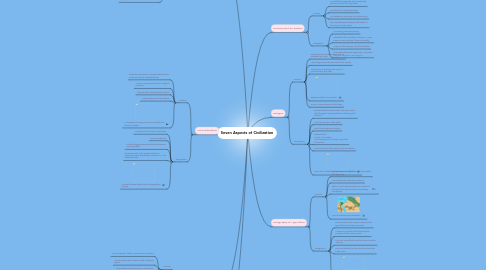
1. Social Structure & Family Life
1.1. Sumeria
1.1.1. 3 social groups: nobles, commoners, and slaves
1.1.2. Female slaves used to weave cloth and grind grains
1.1.3. Commoners worked as farmers, merchants, and crafts people
1.1.4. Men were masters of the house and could sell his wife or children into slavery
1.2. Shang/Zhou
1.2.1. The Shang King ruled from the capital city of Anyang
1.2.2. A typical family contains a mother, father, sons and unmarried daughters. They all live together in the same home
1.2.3. The father is in charge and makes all decisions of the family
1.2.4. The king's kingdom was divided into different territories that were ruled by aristocratic military leaders
2. Art & Education
2.1. Sumeria
2.1.1. Education took place in temples directed by a priest and was for wealthy families.
2.1.2. Art was complex and used for religious purposes
2.1.3. Clay was the most abundant material
2.1.4. Mainly used paint and sculpture
2.1.5. An example of a clay piece of art made by the Sumerian people
2.2. Shang/Zhou
2.2.1. Created lots of literature and books
2.2.2. Bronze sculptures
2.2.3. As technology improved architecture became more important
2.2.4. Educated most of the people within the dynasty and was directed by Confucius or "The Great Educator"
2.2.5. An artistic bronze bowl from the Shang/Zhou dynasty
3. Economy & Trade
3.1. Sumeria
3.1.1. Relied heavily on agriculture
3.1.2. Industry became very important
3.1.3. Copper, tin, and timber were exchanged with dried fish, wool,wheat, and metal goods.
3.1.4. The invention of the wheel made getting things around much easier, causing quicker trade.
3.2. Shang/Zhou
3.2.1. Due to a lack of written language, little is known about their economy.
3.2.2. They focused on daily farming instead of sudden growth.
3.2.3. They had a monopoly on the bronze industry.
3.2.4. The silk road was used for trading and it brough cultural immersion
4. Science & Technology
4.1. Sumeria
4.1.1. They had many tools including an early form of glue.
4.1.2. They had newer forms of weapons like axes, swords, and lance points.
4.1.3. They came up with the idea of hours into 60 minutes, and minutes into 60 seconds.
4.1.4. They had newer form of technology like boats, irrigation systems, number systems, and the first wheeled vehicles.
4.2. Shang/Zhou
4.2.1. They begun using bronze for weapons and utensils.
4.2.2. They used fertilizers and pesticides for farming.
4.2.3. They had early form of healing techniques like acupuncture and Moxibustion (the burning of moxa on or near a person's skin as a counter irritant).
4.2.4. The Zhou dynasty produced some of the fist geographical maps.
5. Government & Leaders
5.1. Sumeria
5.1.1. Controlled by kings who were assisted by priests and others of high status
5.1.2. Sectioned into city-states based
5.1.3. Mix between a monarchy and a democracy
5.1.4. The city-states were sectioned off based on farming and trade routes
5.2. Shang/Zhou
5.2.1. Monarchy governed by kings
5.2.2. Established the Mandate of Heaven; A rulers power can be revoked if they act unjustly
5.2.3. Kings sent the warriors into lots of battles
5.2.4. There were three wise sage kings. They were king Yao, King Shun, and King Yu.
6. Religion
6.1. Sumeria
6.1.1. Each town and city was believed to be protected by a god
6.1.2. Many religious events were held at the temple
6.1.3. The believe everything that occurs is preplanned by the gods
6.1.4. Religious artifact of Sumerians
6.1.5. Gods in Sumerian were called dingir
6.2. Shang/Zhou
6.2.1. Believed that ancestors lived in the spirit world with the gods, and granted them either good or bad luck
6.2.2. That life carried on after death
6.2.3. Didn't have organized religion
6.2.4. Believed that: Family = foundation and Learning and Literacy= important and valued
6.2.5. Praised the God-like Kings of early civilizations
6.2.6. Tomb tells us that they believed in the afterlife.
7. Geography & Agriculture
7.1. Sumeria
7.1.1. The two rivers were the basis for how wealthy the region was
7.1.2. Was located near the fertile crescent
7.1.3. Eridu, Ur, and Urak were the main cities and controlled the majority of the surrounding countryside
7.1.4. Map of Sumerian river civilization
7.2. Sheng/Zhou
7.2.1. The Silk Road made a great impact on the agriculture and trading purposes.
7.2.2. It carries rich yellow silt all the way from Mongolia to the Pacific Ocean
7.2.3. The land is very fertile and has very rich soil for farming
7.2.4. The river stretches across China for more than 2,900 miles
7.2.5. Map of Shang/Zhou river civilization
